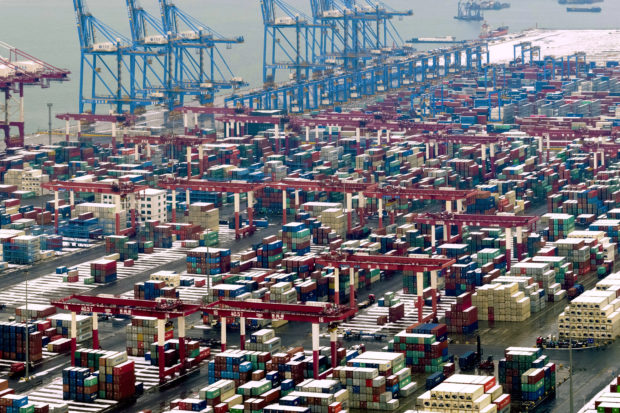
In this Feb. 14, 2019, photo, trucks move around containers stored at a port in Qingdao in east China’s Shandong province. AP
WASHINGTON, United States — US President Donald Trump on Monday effectively ended a six-month trade truce with China, with top US officials accusing Beijing of backtracking ahead of a key round of negotiations this week.
Tariffs on $200 billion in Chinese merchandise will more than double to 25 percent at 12:01 am (0401 GMT) Friday, US Trade Representative Robert Lighthizer announced, according to media reports.
The announcement shattered the calm of recent weeks. Trump’s top trade negotiators said Monday the world’s two largest economies were close to an agreement but Beijing reversed course in recent days.
The threat also tanked stock markets worldwide and frightened US farmers and businesses caught in the crossfire who have been banking on a resolution to the year-long conflict that has engulfed $360 billion in two-way trade.
Prior to the announcement, US markets had recovered as investors apparently decided Trump was using tariff threats made Sunday a negotiating tactic.
“Over the course of the last week or so, we’ve seen an erosion in commitments by China, I would say retreating from commitments that have already been made in our judgment,” Lighthizer was quoted as saying Monday.
Treasury Secretary Steven Mnuchin said the negotiations were 90 percent complete but he told reporters that in recent days the talks went “substantially backward,” according to the reports.
Trump had lashed out on Sunday, vowing not only to ratchet up existing tariffs this week but also to extend the 25 percent punitive duties to the remaining $350 billion in Chinese goods imported into the country each year.
“The Trade Deal with China continues but too slowly as they attempt to renegotiate. No!” Trump wrote on Twitter.
Despite the tweeted threats, officials in Beijing had said earlier Monday the talks would continue this week.
Vice Premier Liu He was expected to lead the delegation but the US officials said they had had no contact with him for the prior 24 hours.
‘Precarious’ position
Comments from officials in recent weeks indicated the sides were making progress towards an agreement aimed at addressing longstanding concerns about the forced transfer or outright theft of American technology, as well as reducing the US trade deficit with China.
Trump has continued to equate the US trade deficit as a loss or as payments to trading partners and tariffs as payments from the offending country to the United States. But economists stress that it is American businesses and consumers who pay the tariffs and are hurt by higher prices.
William Reinsch, trade policy expert at the Center for Strategic and International Studies, said China will never meet all the US demands.
“At some point the president is going to figure out that they’re not going to give him everything he wants,” he told AFP.
That will put Trump in “a precarious political position,” whether “to accept an agreement that will be criticized as weak, or not to have an agreement and be criticized for failing.”
“And I can imagine that he is unhappy about that.”
Freya Beamish of Pantheon Macroeconomics warned that Trump’s aggressive tactics could backfire.
“It is much harder for China’s leaders to do that if it looks like they have signed with a gun to their heads.”
Restrained growth
US manufacturers and farmers were becoming more optimistic amid signs of progress and comments from officials that the talks were entering their final phase, reinforced by reports Beijing was sending 100 officials to this week’s negotiations.
Trump credits the tariffs with the strong first quarter growth but economists and businesses have complained that the trade conflict is in fact hurting the bottom line and the uncertainty is causing them to delay investment.
Jake Colvin of the National Foreign Trade Council, a pro-trade US business group said the tariffs “come at the expense of American businesses and farmers and consumers as well.”
And escalating the tariffs to the remaining Chinese goods, which would be expected to spark further retaliation from Beijing, would cut 0.3 percentage points off US growth, according to Oxford Economics.
Wells Fargo analyst Paul Christopher said with all the work that has gone into the talks, he still expects the two sides to reach an agreement but he warned that “new tariffs or a breakdown in talks could undermine that outlook quickly,” slowing global growth and trade. /cbb